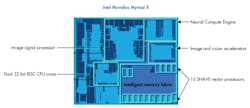Intel’s Myriad X Vision Chip Incorporates Neural Network
Intel does its Movidius Myriad 2 MA2x5x vision processing unit (VPU) one better with the latest Myriad X VPU (see figure). The Myriad X includes the same type of 128-bit VLIW SHAVE (Streaming Hybrid Architecture Vector Engine) processors, but bumps the number up to 16. It also has the same 32-bit RISC processors. It also increases the number of MIPI lanes to 16, allowing for support of eight HD cameras. The biggest change is the addition of more hardware accelerators and neural network hardware.
The Myriad 2 is already being used with drones like DJI’s $499 SPARK, where its camera is now being used for collision avoidance and pilot gesture recognition. The challenge for the Myriad 2 is that some deep neural network (DNN) processing needs to be done in software, either on the Myriad 2 or the host processor. The Myriad X can do this in hardware, which significantly speeds up the process and lowers the amount of power required to get a result.
The Myriad 2 will still be available, providing a lower entry point to Intel’s VPU series, but the Myriad X is where the heavy lifting will be done. The latter can deliver 4 TOPS of performance, with the DNN engine contributing a quarter of that. The hardware accelerators include things like hardware encode and decode of H.264 and Motion JPEG, as well as a warp engine for handling fish eye lens, dense optical flow, and stereo depth perception. The latter can handle 720p streams at 180 frames/s.
The 450 Gbyte/s intelligent memory fabric and 2.5 Mbytes of on-chip memory form a multiport memory system linked to all the major functions on the system. This is key to minimizing data movement that is often used in other systems, or where components are found on other chips. This allows data to be dumped into memory from the eight HD camera streams at a rate up to 700 Mpixels/s.
Accelerators and processors can massage the data that is then logically passed to the next stage in the process pipeline. One of the RISC processors normally handles pipeline scheduling. This reduces latency and power consumption. The system can operate with a host or standalone. It supports secure boot and has secure storage.
Intel is providing the Myriad Development Kit (MDK) software framework that operates on the Myriad 2 and Myriad X platforms. The two are not code-compatible, especially given the difference in hardware like the Myriad X’s neural network support, but recompilation provides functionally similar platforms. This is important because of the plug-in approach that will allow developers to choose what plug-in features will be used in a pipeline.
The Myriad X addresses commercial and industrial solutions. It can be used in vehicles like drones, but it does not target automotive applications; Intel has other products from Mobileye that address this space. General delivery is expected in 2018. The MA2085 provides an external memory interface, while the MA2485 has in-package LPDDR4 memory.
The Myriad 2 is already being used in platforms like the DJI SPARK and Intel’s own Movidius Neural Compute Stick. The Myriad X highlights how important machine learning and DNN is becoming. It will significantly change what can be done with a single camera, and its ability to handle up to eight HD cameras opens up major possibilities that can change how sensors are viewed within industrial and commercial systems.
About the Author
William G. Wong
Senior Content Director - Electronic Design and Microwaves & RF
I am Editor of Electronic Design focusing on embedded, software, and systems. As Senior Content Director, I also manage Microwaves & RF and I work with a great team of editors to provide engineers, programmers, developers and technical managers with interesting and useful articles and videos on a regular basis. Check out our free newsletters to see the latest content.
You can send press releases for new products for possible coverage on the website. I am also interested in receiving contributed articles for publishing on our website. Use our template and send to me along with a signed release form.
Check out my blog, AltEmbedded on Electronic Design, as well as his latest articles on this site that are listed below.
You can visit my social media via these links:
- AltEmbedded on Electronic Design
- Bill Wong on Facebook
- @AltEmbedded on Twitter
- Bill Wong on LinkedIn
I earned a Bachelor of Electrical Engineering at the Georgia Institute of Technology and a Masters in Computer Science from Rutgers University. I still do a bit of programming using everything from C and C++ to Rust and Ada/SPARK. I do a bit of PHP programming for Drupal websites. I have posted a few Drupal modules.
I still get a hand on software and electronic hardware. Some of this can be found on our Kit Close-Up video series. You can also see me on many of our TechXchange Talk videos. I am interested in a range of projects from robotics to artificial intelligence.



